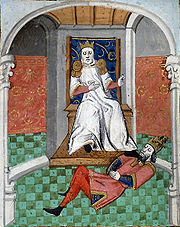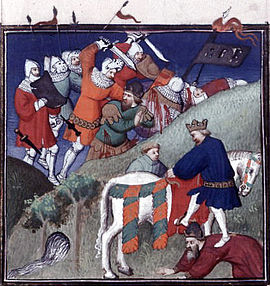- Alp Arslan
-
Alp Arslan Sultan of Great Seljuq Reign 1064–1072 Coronation 27 April 1064 Full name Muhammad bin Da'ud Chaghri Born 1029 Died 15 December 1072 (aged 43) Place of death Oxus River, Turkestan Buried Merv, Great Seljuq Empire Predecessor Tughril Successor Malik Shah I Royal House Seljuq dynasty Father Chaghri Beg Religious beliefs Sunni Islam Alp Arslan (الب ارسلان, alb arslān or آلب آرسلان, ālb ārslān, 1029 – 15 December 1072) was the third sultan of the Seljuq dynasty and great-grandson of Seljuk, the eponymous founder of the dynasty. He assumed the name of Muhammad bin Da'ud Chaghri when he embraced Islam, and for his military prowess, personal valour, and fighting skills he obtained the surname Alp Arslan, which means "Heroic Lion"[1] in Turkmen.
Contents
Career
Alp Arslan led Seljuq Turks to victory against the Byzantines in 1071.
He succeeded his father Chagri Begh as governor of Khorasan in 1059. When his uncle Tughril died he was succeeded by Suleiman, Alp Arslan's brother. Alp Arslan and his uncle Kutalmish both contested this succession. Alp Arslan defeated Kutalmish for the throne and succeeded on 27 April 1064 as sultan of Great Seljuq, and thus became sole monarch of Persia from the river Oxus to the Tigris.
In consolidating his empire and subduing contending factions he was ably assisted by Nizam ul-Mulk, his vizier, and one of the most eminent statesmen in early Muslim history. With peace and security established in his dominions, he convoked an assembly of the states and declared his son Malik Shah I his heir and successor. With the hope of capturing Caesarea Mazaca, the capital of Cappadocia, he placed himself at the head of the Turkish cavalry, crossed the Euphrates and entered and invaded the city. He then marched into Armenia and Georgia, which he conquered in 1064.
Byzantine struggle
In 1068, en route to Syria, Alp Arslan Oush invaded the Byzantine Empire. The Emperor Romanos IV Diogenes, assuming the command in person, met the invaders in Cilicia. In three arduous campaigns, the first two of which were conducted by the emperor himself while the third was directed by Manuel Comnenos (great-uncle of Emperor Manuel Comnenos), the Turks were defeated in detail in 1070 and driven across the Euphrates. In 1071 Romanos again took the field and advanced with possibly 30,000 men, including a contingent of the Cuman Turks as well as contingents of Franks and Normans, under Ursel de Baieul, into Armenia.
At Manzikert, on the Murat River, north of Lake Van, Diogenes was met by Alp Arslan. The sultan proposed terms of peace, which were rejected by the emperor, and the two forces met in the Battle of Manzikert. The Cuman mercenaries among the Byzantine forces immediately defected to the Turkish side; and, seeing this, "the Western mercenaries rode off and took no part in the battle."[2] The Byzantines were totally routed.
Emperor Romanos IV was himself taken prisoner and conducted into the presence of Alp Arslan, who treated him with generosity, and, terms of peace having been agreed to, dismissed him, loaded with presents and respectfully attended by a military guard. The following conversation is said to have taken place after Romanos was brought as a prisoner before the Sultan[3]:
- Alp Arslan: "What would you do if I was brought before you as a prisoner?"
- Romanos: "Perhaps I'd kill you, or exhibit you in the streets of Constantinople."
- Alp Arslan: "My punishment is far heavier. I forgive you, and set you free."
Alp Arslan's victories changed the balance in near Asia completely in favour of the Seljuq Turks and Sunni Muslims. While the Byzantine Empire was to continue for nearly another four centuries, and the Crusades would contest the issue for some time, the victory at Manzikert signalled the beginning of Turkish ascendancy in Anatolia. Most historians, including Edward Gibbon, date the defeat at Manzikert as the beginning of the end of the Eastern Roman Empire. Certainly the entry of Turkic farmers following their horsemen ended the themes in Anatolia which had furnished the Empire with men and treasure.
State organization
 Alp Arslan humiliating Emperor Romanos IV after the Battle of Manzikert. From a 15th-century illustrated French translation of Boccacio's De Casibus Virorum Illustrium.
Alp Arslan humiliating Emperor Romanos IV after the Battle of Manzikert. From a 15th-century illustrated French translation of Boccacio's De Casibus Virorum Illustrium.
Alp Arslan's strength lay in the military realm. Domestic affairs were handled by his able vizier, Nizam al-Mulk, the founder of the administrative organization which characterized and strengthened the sultanate during the reigns of Alp Arslan and his son, Malik Shah. Military fiefs, governed by Seljuq princes, were established to provide support for the soldiery and to accommodate the nomadic Turks to the established Anatolian agricultural scene. This type of military fiefdom enabled the nomadic Turks to draw on the resources of the sedentary Persians, Turks and other established cultures within the Seljuq realm, and allowed Alp Arslan to field a huge standing army, without depending on tribute from conquest to pay his soldiery. He not only had enough food from his subjects to maintain his military, but the taxes collected from traders and merchants added to his coffers sufficiently to fund his continuous wars.
According to the poet Saadi Shirazi: Arslan possessed a fort, which raised at the height of Alwand, from all were those within its walls, for its roads were a labyrinth, like the curls of a bride. From a learned traveler Arslan once inquired: "Didst thou ever, in thy wanderings, see a fort as strong as this?". "Splendid it is," was the travelers reply, "but methinks not it confers much strength. Before thee, did not other kings possess it for a while, then pass away? After thee, will not other kings assume control, and eat the fruits of the tree of thy hope?"
In the estimation of the wise, the world is a false gem that passes each moment from one hand to another. (the fort was sacked by the Mongols led by Hulagu).
Suleiman ibn Kutalmish was the son of the contender for Arslan's throne; he was appointed governor of the north-western provinces and assigned to completing invasion of Anatolia. An explanation for this choice can only be conjectured from Ibn al-Athir’s account of the battle between Alp-Arslan and Kutalmish, in which he writes that Alp-Arslan wept for the latter's death and greatly mourned the loss of his kinsman.
Death
The dominion of Alp Arslan after Manzikert extended over much of western Asia. He soon prepared to march to the conquest of Turkestan, the original seat of his ancestors. With a powerful army he advanced to the banks of the Oxus. Before he could pass the river with safety, however, it was necessary to subdue certain fortresses, one of which was for several days vigorously defended by the governor, Yussuf el-Harezmi, a Khwarezmian. He was, however, obliged to surrender and was carried a prisoner before the sultan, who condemned him to death. Yussuf, in desperation, drew his dagger and rushed upon the sultan. Alp Arslan, who took great pride in his reputation as the foremost archer of his time, motioned to his guards not to interfere and drew his bow, but his foot slipped, the arrow glanced aside and he received the assassin's dagger in his breast. Alp Arslan died four days later from this wound on 25 November 1072 in his 42nd year, and was taken to Merv to be buried next to his father Chaghri Beg. Upon his tomb lies the following inscription:
- “O those who saw the sky-high grandeur of Alp Arslan, behold! He is under the black soil now...”
As he lay dying, Alp Arslan whispered to his son that his vanity had killed him. "Alas," he is recorded to have said, "surrounded by great warriors devoted to my cause, guarded night and day by them, I should have allowed them to do their job. I had been warned against trying to protect myself, and against letting my courage get in the way of my good sense. I forgot those warnings, and here I lie, dying in agony. Remember well the lessons learned, and do not allow your vanity to overreach your good sense..."
Legacy
Alp Arslan's conquest of Anatolia from the Byzantines is also seen as one of the pivotal precursors to the launch of the crusades.
From 2002 to July 2008 under Turkmen calendar reform, the month of August was named after Alp Arslan.
Seljuq dynasty Great Seljuq Empire Seljuq • Tughril • Chaghri • Alp Arslan • Malik-Shah I • Mahmud I • Barkiyaruq • Malik-Shah II • Mehmet Tapar • SanjarSeljuqs of Hamedan (West Iran) Seljuqs of Kerman (South Iran) Seljuqs of Syria Seljuks of Turkey (Rûm) Kutalmish • Suleyman I • Kilij Arslan I • Melikshah • Mesud I • Kilij Arslan II • Kaykhusraw I • Suleiman II • Kilij Arslan III • Keykaus I • Kayqubad I • Kaykhusraw II • Kaykaus II • Kilij Arslan IV • Kayqubad II • Kaykhusraw III • Mesud II • Kayqubad III • Kayqubad IIIReferences
- ^ "Alp Arslan." Encyclopedia of World Biography. 2004. Encyclopedia.com. (September 5, 2011). http://www.encyclopedia.com/doc/1G2-3404700163.html
- ^ Runciman, Steve (1992). The First Crusade. Cambridge University Press.
- ^ Peoples, R. Scott Crusade of Kings Wildside Press LLC, 2008. p. 13. ISBN 0809572214, 9780809572212
Preceded by
ToghrülSultan of Great Seljuq
1063–1072Succeeded by
Malik Shah ICategories:- 1029 births
- 1072 deaths
- Seljuk rulers
- Monarchs of Persia
- Muslim generals
- Byzantine–Seljuq Wars
- Great Seljuq Empire
Wikimedia Foundation. 2010.

